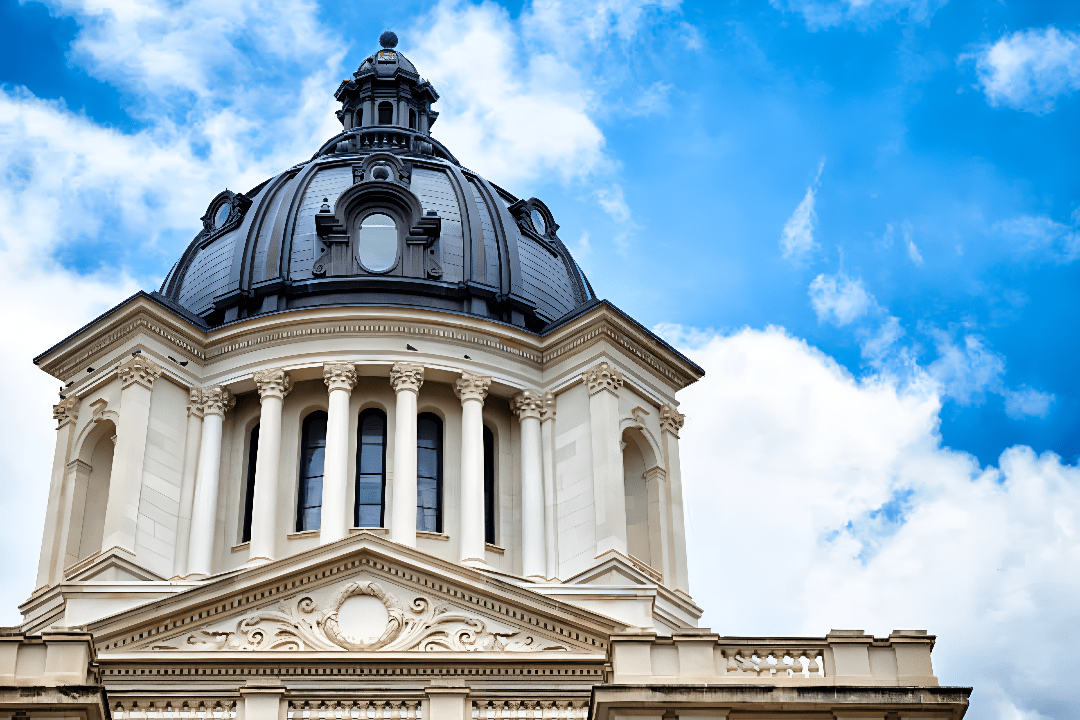Understanding South Dakota sales tax is crucial for any business operating in the state.
This guide covers everything you need to know to stay compliant:
- Nexus Requirements: When you need to collect tax.
- Permit Applications: How to register with the state.
- Taxable Items: What items are subject to tax.
- Filing Returns: How to file your tax returns accurately.
Whether you’re a local business, an online merchant, or a tax professional, this guide provides essential information to help you understand and navigate South Dakota sales tax rules effectively.
What Is the Sales Tax Rate in South Dakota?
As of February 2025, the statewide sales tax rate in South Dakota is 4.2%. This rate was reduced from 4.5% on July 1, 2023, and is set to revert back to 4.5% on July 1, 2027.
In addition to the state sales tax, local jurisdictions in South Dakota impose their own sales taxes, ranging from 0% to 2%. Consequently, the total sales tax rate in South Dakota can vary significantly based on the sale location, with combined rates typically falling between 4.2% and 6.5%.
South Dakota Sales and Use Tax Overview
As a business owner in South Dakota, it is crucial to understand your responsibilities regarding sales and use tax. You must collect state taxes when selling taxable goods and services and remit these taxes to the appropriate state authorities. The South Dakota Department of Revenue (DOR) oversees the administration of sales and use tax in the state.
Sales Tax
Sales tax in South Dakota is applied to the sale of tangible personal property and certain services. This means that when you sell products like clothing, electronics, or even some services, you must charge your customers the applicable sales tax rate, which currently stands at 4.2% at the state level, plus any local taxes that may apply.
Use Tax
Use tax complements sales tax and is applicable when sales tax has not been collected at the time of purchase. If you buy goods for use in South Dakota without paying sales tax — perhaps from an out-of-state seller — you must pay use tax at the same rate as the sales tax. This ensures that all purchases made for use in South Dakota contribute fairly to state revenue.
Taxable items in South Dakota include:
- Most Physical Goods: This encompasses various items such as clothing, electronics, furniture, and alcoholic beverages.
- Certain Services: Specific services are also taxable, including construction services, car washing, and digital products like Software as a Service (SaaS).
Not all goods and services are subject to South Dakota sales tax exemption. Here’s a list of included items:
- Groceries
- Prescription drugs
- Medical devices
- Farm equipment
- Sales to nonresidents
- Newspapers
For detailed information about exemptions and specific conditions under which they apply, Commenda advises you to consult the South Dakota Department of Revenue’s website and resources.
When Do Businesses Need to Collect Sales Tax in South Dakota?
Understanding when to collect sales tax is crucial for businesses operating in South Dakota. The responsibility to collect South Dakota sales tax arises under specific conditions primarily related to the concept of nexus.
Nexus Requirements
Businesses must collect sales tax if they establish a nexus in South Dakota. Nexus can be categorized into two main types:
1. Physical Nexus
A business has a physical nexus in South Dakota if it maintains a tangible presence in the state. This can include:
- Having a brick-and-mortar store, office, or warehouse.
- Employing staff or sales representatives who work within the state.
- Participating in trade shows, fairs, or conferences located in South Dakota.
If any of these conditions apply, the business must collect sales tax on taxable sales made within the state.
2. Economic Nexus
Economic nexus applies to businesses that do not have a physical presence but exceed certain economic thresholds. As of July 1, 2023, the criteria for establishing South Dakota economic nexus is:
- Gross revenue of $100,000 from sales into South Dakota during the previous or current calendar year.
The previous requirement of having 200 separate transactions has been eliminated, meaning that businesses only need to meet the revenue threshold to trigger sales tax obligations.
Also read: US Sales Tax Guide: Introduction, Nexus, and How to Calculate Rates
Failure to Collect South Dakota Sales Tax
Failing to collect sales tax in South Dakota can have significant consequences for businesses. Understanding the implications and responsibilities associated with sales tax collection is essential for compliance and financial health.
Consequences of Failing to Collect Sales Tax
Late filing or payment of South Dakota sales tax can result in the following penalties:
- Failure to File:
- A penalty of 10% of the tax liability is assessed if a return is not received within 30 days following the month the return is due.
- The minimum penalty is $10, even if no tax is due.
- Failure to Pay:
- If you do not pay the tax by the due date, you will incur a penalty of 10% of the unpaid tax amount.
- Interest may also accrue on any unpaid taxes, compounding the financial burden.
- Interest Charges:
- An interest charge of 1% will be assessed each month on any past-due tax until the tax is paid in full. A minimum of $5.00 interest is due the first month.
- Penalty and interest are considered the same as tax for the purposes of collection and enforcement, including liens, distress warrants, and criminal violations.
Also read: U.S. Sales Tax Penalties: What Are the Penalties for Filing Late[Not Paying]?
South Dakota Sales Tax for Out-of-State and Amazon FBA Program Sellers
Out-of-state businesses selling to South Dakota residents must comply with the state’s economic nexus rules. This includes remote sellers utilizing the Fulfillment by Amazon (FBA) program, who need to know whether their inventory is stored in South Dakota.
If you are an FBA seller, you can check your inventory locations using the Inventory Event Detail Report available in Amazon Seller Central. If your inventory is located in South Dakota, you have likely established economic nexus and are required to collect sales tax on sales made to customers in the state. The threshold for this obligation is $100,000 in gross revenue from sales into South Dakota during the current or previous calendar year.
In case of any uncertainties regarding your sales tax obligations, it is advisable to consult a tax expert to ensure compliance with South Dakota’s sales tax regulations.
Registering for a South Dakota Tax Licence
To legally collect South Dakota sales tax, you must first register for a sales tax license with the South Dakota Department of Revenue (DOR). This registration is mandatory for businesses that sell tangible personal property or services subject to sales tax in the state.
To register for a seller’s permit, follow these steps:
- Visit the South Dakota Department of Revenue (DOR) website: You can apply online through the DOR’s Tax License Application portal.
- Choose your application method:
- Without an Account: Complete the application without creating a user profile.
- With an Account (Recommended): Create an online user profile to save future applications and renewals.
- Provide Required Information: You will need to submit details such as:
- Legal business name and address
- Federal Employer Identification Number (EIN)
- Business entity structure (e.g., LLC, Corporation)
- Estimated annual taxable sales in South Dakota
- North American Industry Classification System (NAICS) code
The application is free, and once submitted, you will receive confirmation and your seller’s permit via email.
How to Collect Sales Tax in South Dakota
- Determine Tax Rate: The state sales tax rate is 4.2%, plus any applicable local taxes based on the buyer’s location. Use tools like the South Dakota Department of Revenue Sales Tax Rate Lookup Tool to help determine the correct tax for any location
- Sales Tax Collection Process:
- Set up your point-of-sale system to automatically calculate and apply the correct sales tax at checkout.
- Clearly display the sales tax amount on customer receipts.
- Remittance:
- Collect sales tax from customers at the time of sale.
- Remit collected sales tax to the South Dakota Department of Revenue during your designated filing period (monthly, quarterly, or annually, depending on your sales volume).
- Record Keeping: Maintain accurate records of all sales transactions and taxes collected for compliance and reporting.
Tax-Exempt Customers
Certain customers may qualify for tax-exempt purchases in South Dakota. These typically include:
- Nonprofit organizations
- Government entities
- Resellers purchasing goods for resale
To process tax-exempt sales, businesses must obtain a valid South Dakota sales tax exemption certificate from the customer, which should be kept on file to substantiate the exemption during audits.
Filing Sales Tax Returns in South Dakota
Once you’re registered to collect sales tax in South Dakota, it’s crucial to understand how and when to file your sales tax returns. This section outlines the filing frequency, the steps involved, and how to pay your sales tax liability.
Filing Frequency
Businesses licensed with the South Dakota Department of Revenue will be informed of their filing frequency, which may be monthly, quarterly, or annually, depending on their tax liability. Returns can be filed either online or via a pre-printed paper return supplied by the Department.
| Filing Frequency | Due Date |
|---|---|
| Monthly | By the 20th of the following month. For example, the return for January is due by February 20th. |
| Quarterly | By the last day of the month following the end of the quarter. For example, the Q1 return (January – March) is due by April 20th. |
| Annually | By January 31st of the following year. |
Filing Steps
- Determine Your Filing Frequency: Based on your sales tax collection, identify whether you need to file monthly, quarterly, or annually.
- Access the South Dakota DOR Website: Login to the South Dakota Department of Revenue’s online portal.
- Complete the Sales Tax Return Form: Fill out the required information, including total sales, taxable sales, and sales tax collected.
- Review and Submit: Double-check your entries for accuracy before submitting the return electronically.
- Keep Records: Maintain copies of your filed returns and any supporting documentation for at least three years.
How to Pay Your South Dakota Sales Tax
- Electronic Payment: Electronic filers can set up their payment option and date, with payments due on or before the 25th of the month.
- Paper Payment: For paper filers, the payment is due at the same time as the return.
Also read: US Sales Tax Compliance Basics: Registration, Exemptions, and Filing Made Easy
Using Sales Tax Automation Tools
Sales tax compliance can be complex, especially for businesses operating in multiple states. Commenda offers an effective solution with its sales tax automation tools. These tools simplify sales tax calculation, collection, and remittance, ensuring businesses remain compliant with state regulations.
With built-in reporting, remittance, and expert accounting support, Commenda lets you focus on what matters most: growing your business. Trusted by over 250+ businesses across borders. Click here to learn more.
South Dakota Sales Tax Compliance Checklist
To ensure compliance with South Dakota sales tax regulations, follow this streamlined checklist:
- Registration: Obtain a South Dakota seller’s permit from the Department of Revenue.
- Sales Tax Collection: Set up your system to automatically calculate and collect the correct South Dakota sales tax based on the buyer’s location.
- Record Keeping: Maintain accurate records of all sales transactions, including sales tax collected.
- Filing Sales Tax Returns: Determine your filing frequency (monthly, quarterly, or annually) and submit your returns by the due date.
- Payment: Pay any sales tax due electronically through the DOR’s online portal or by check/money order by the payment deadline.
- Audit Preparedness: Keep all records and documentation for at least three years to prepare for potential audits.
How Should I Prepare for South Dakota Sales Tax Audits and Appeals?
Sales tax audits are a routine part of business operations. Being prepared can significantly reduce stress and ensure a smoother process. This section outlines how to prepare for a South Dakota sales tax audit and what to expect during the process.
Understanding the Audit Process
The Department of Revenue conducts sales tax audits in South Dakota to ensure compliance with tax laws. The audit typically involves reviewing your sales records, tax returns, and supporting documentation to verify that the correct sales tax amount has been collected and remitted. Understanding this process is crucial for adequate preparation.
Steps to Prepare for an Audit
- Organize Records: Gather all relevant documents, including sales tax returns, invoices, receipts, exemption certificates, and any correspondence with the Department of Revenue.
- Review Sales Transactions: Conduct a thorough review of your sales transactions to ensure accuracy in reported sales and taxes collected.
- Understand Tax Laws: Familiarize yourself with South Dakota sales tax laws and regulations to identify any areas where you may need clarification or further documentation.
- Consult a Professional: Consider engaging a tax professional or accountant who specializes in sales tax compliance to assist with your audit preparation.
During the Audit
- Be Cooperative: Provide requested documents and information promptly and be open to questions from the auditor.
- Take Notes: Document the auditor’s questions and comments for future reference, especially if you need to appeal any findings.
- Stay Professional: Maintain a professional demeanor throughout the audit process, as this can facilitate a more positive interaction with the auditor.
South Dakota Sales Tax Rates by City
In South Dakota, the sales tax consists of a state rate and additional local rates that vary by city. The current state sales tax rate is 4.2%. Below are some examples of combined sales tax rates for various cities in South Dakota:
| City | Total Sales Tax Rate | City | Total Sales Tax Rate |
|---|---|---|---|
| Spearfish | 6.2% | Yale | 5.2% |
| Mitchell | 6.2% | Brandon | 6.2% |
| Tea | 6.2% | Iroquois | 5.2% |
| Morristown | 5.7% | Hazel | 5.2% |
| Sioux Falls | 6.2% | Vermillion | 6.2% |
| Madison | 6.2% | Renner | 4.2% |
| Utica | 5.2% | Hot Springs | 6.2% |
| Orient | 5.2% | Wasta | 5.2% |
Tired of keeping up with changing sales tax rates in South Dakota?
Commenda automates the process, eliminating the hassle and reducing the risk of errors. Built-in reporting and expert support make sales tax compliance easy. Schedule a free call with our sales tax experts now!
FAQs
What is the current South Dakota sales tax rate?
The state sales tax rate in South Dakota is 4.2%, but combined rates can range from 4.5% to 6.5% depending on local taxes imposed by municipalities.
When do I need to collect sales tax in South Dakota?
You must collect sales tax if you have nexus in South Dakota, are selling taxable goods or services to residents, and your buyers must pay sales tax.
How do I register for a seller’s permit?
To register for a seller’s permit, visit the South Dakota Department of Revenue website and complete the online application, providing necessary business information.
What items are exempt from sales tax in South Dakota?
South Dakota sales tax exemption applies to items like food stamp purchases, motor vehicle sales, and certain services. Nonprofit organizations and government entities may also qualify for exemption.
How can I prepare for a sales tax audit?
Organize your records, review your transactions for accuracy, understand relevant tax laws, and consider consulting a tax professional.
Are services taxable in South Dakota?
Yes, South Dakota is one of the few states that taxes most services in addition to tangible goods
Has South Dakota changed its economic nexus threshold recently?
Yes, effective July 1, 2023, this state eliminated the 200-transaction threshold. Now, only the $100,000 gross revenue threshold applies for establishing a South Dakota economic nexus.










